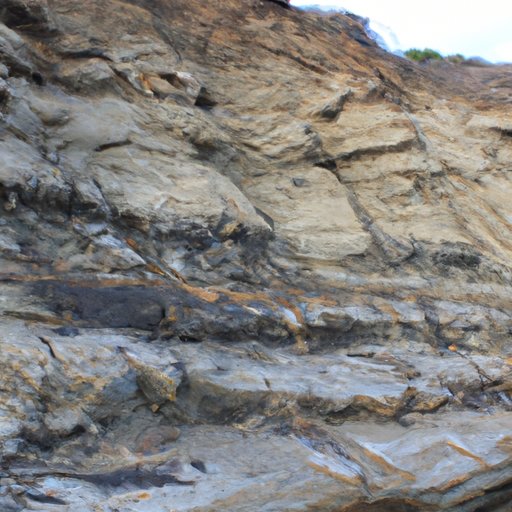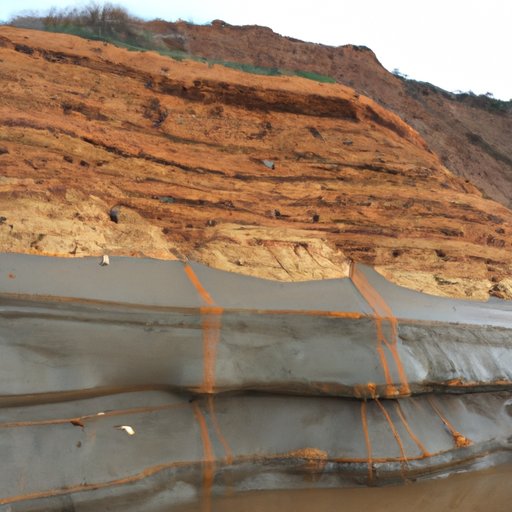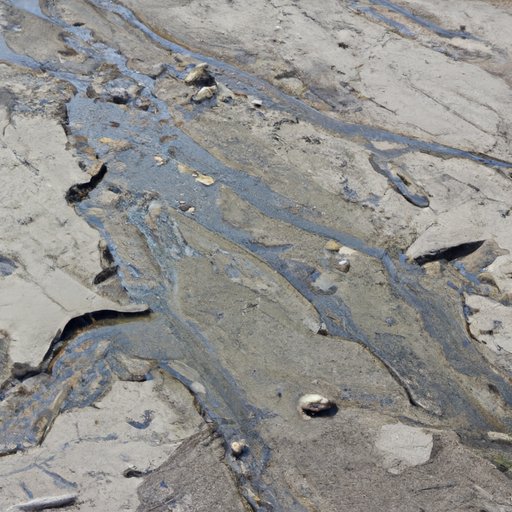Introduction
Sedimentation is an important process in the Earth’s geology. It occurs when particles settle out of a fluid, such as water or air, and accumulate on the surface of the Earth. Sedimentation plays a key role in the formation of landforms and ecosystems, and it has a significant impact on human activities. This article will explore sedimentation and its role in the Earth, discussing the different types of sediments and sedimentary rocks, as well as their formation and impact on landforms and ecosystems.

Exploring Sediments: What They Are and How They Form
Sediments are solid particles that come from various sources, such as rocks and plants, and settle out of fluids, such as water or air. They can be composed of minerals, rock fragments, organic matter, and other substances. The rate at which sediments accumulate depends on several factors, including the type of fluid, the velocity of the fluid, and the size and density of the particles.
The process of sedimentation occurs when particles settle out of a fluid and accumulate on the surface of the Earth. This process is driven by gravity, and it is often aided by turbulence, which helps to move the particles along. The rate of sedimentation is affected by the size, shape, and density of the particles, as well as the velocity of the fluid. In addition, the presence of obstacles, such as rocks or plants, can also affect the rate of sedimentation.
There are several factors that influence the formation of sediments. For example, weathering and erosion can break down rocks and other materials into small particles that can then be carried away by wind or water. In addition, biological processes such as decomposition can also contribute to the formation of sediments. Finally, sedimentation can also be affected by climate change, with warmer temperatures causing increased erosion and sedimentation.

An Overview of Sedimentary Rocks and Their Formation
Sedimentary rocks are rocks that form from the accumulation of sediment. These rocks are classified based on their composition and texture, and they can range in size from microscopic particles to large boulders. The most common types of sedimentary rocks include sandstone, limestone, shale, and conglomerate.
The process of sedimentary rock formation begins with the deposition of sediment. Over time, these sediments become compacted and cemented together, forming a rock. This process can take millions of years, and it is often accompanied by chemical changes, such as mineral precipitation, that help to form the rock. The composition and texture of the rock will depend on the type of sediment that was deposited, as well as the environment in which the sediment was deposited.

Sedimentation: A Geologic Process That Shapes the Earth
Sedimentation is a geologic process that shapes the Earth. It is responsible for the formation of landforms such as mountains, valleys, and plains, as well as for creating habitats for plants and animals. Sedimentation also plays an important role in the formation of soils, which are essential for plant growth.
Sedimentation also has a significant impact on human activities. For example, sedimentation can cause flooding, which can damage infrastructure and crops. In addition, sedimentation can clog waterways, making them difficult to navigate. Finally, sedimentation can also cause water pollution, as sediment-laden runoff can contain pollutants that can contaminate drinking water supplies.
The Role of Sediments in Ecosystems
Sediments play an important role in aquatic ecosystems. They provide food and habitat for fish, plants, and invertebrates, and they can also help to filter pollutants from water. In addition, sediments can help to stabilize streambanks and shorelines, preventing erosion and preserving habitats.
In addition, sediments can also be beneficial to fish and other aquatic organisms. According to a study conducted by the U.S. Geological Survey, “sediments can act as a refuge for fish eggs and larvae, providing shelter from predators and allowing young fish to grow and develop.” In addition, sediments can also help to increase the diversity of aquatic organisms, as they provide a variety of habitats for different species.
Understanding the Role of Sediments in Aquatic Environments
Although sediments can be beneficial to aquatic ecosystems, they can also cause problems. Excessive amounts of sediment can lead to water pollution, as sediment-laden runoff can contain pollutants such as fertilizers and pesticides. In addition, sediment can clog streams and rivers, reducing water flow and making it difficult for aquatic organisms to survive.
To manage sediment pollution, it is important to identify the sources of sediment and take steps to reduce or eliminate them. Common sources of sediment pollution include construction sites, agricultural activities, and urban runoff. To prevent and control sediment pollution, it is important to implement best management practices, such as silt fences and sediment traps, to capture and remove sediment before it reaches waterways.
Conclusion
Sedimentation is an important process in the Earth’s geology. It is responsible for the formation of landforms and ecosystems, and it has a significant impact on human activities. This article has explored sedimentation and its role in the Earth, discussing the different types of sediments and sedimentary rocks, and how sedimentation affects landforms and ecosystems. In addition, it has highlighted the sources and control of sediment pollution, and the importance of managing sediment pollution to protect aquatic environments.
(Note: Is this article not meeting your expectations? Do you have knowledge or insights to share? Unlock new opportunities and expand your reach by joining our authors team. Click Registration to join us and share your expertise with our readers.)
